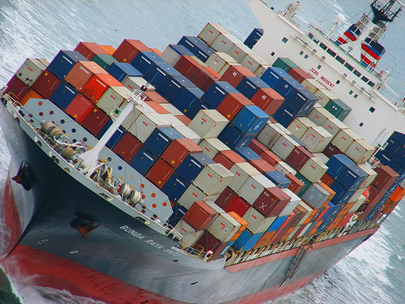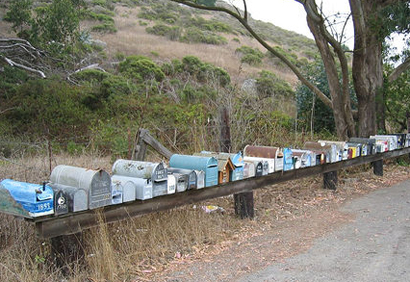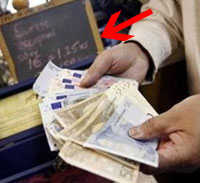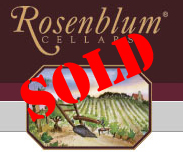Dr Vino's wine blog
wine talk that goes down easy
Reefer madness! Do Americans get worse Australian wine than Japan?

What wine lover doesn’t love the “reefer”? Simmer down, I’m talking about the refrigerated shipping container. Jancis Robinson had a piece in the FT about this chilling topic on Saturday.
As if that didn’t spark your interest in this aspect of logistics, it reminded me of a conversation I had a few weeks ago with a bigwig at a large Australian wine producer. He told me that they track the temperature fluctuations in their transportation containers via sophisticated thermometer. They have data–hour by hour if necessary–for the duration of the voyage. Sometimes the container gets “trans-shipped” and can lie around for weeks on a dock Singapore, a locale not at the top of everyone’s “cool and dry” places.
Here’s the really interesting part: in Japan, the importers demand the data and refuse the wine if it has been cooked. In the US, no. He also said they have different blends for different markets but that is not exactly news.
The only thing worse than having wine be corked is when it is cooked!
Related: “Wireless message in a bottle” (image)
Coalition of the swilling: help the SWRA

I’ve been frustrated many times as a wine enthusiast when looking for a specific wine only to find it available at a store, say, in California. Since I live in New York, California retailers are not legally allowed to send it to me–though whether they will is another question. Eric Asimov, the chief wine critic for the New York Times, has admitted to being a “lawbreaker” as a result of these laws. Other retailers, such as Sam’s Wine in Chicago, will not ship to New York.
As a wine enthusiast, I’m for greater liberalization of wine shipping laws. Freer markets means greater availability and probably lower prices. The Supreme Court decision in 2005 paved the way for greater possibilities of shipping directly from wineries to consumers. But the legal situation of shipping from out-of-state retailers remains a murky area, illegal on the books of too many states.
A quick and dirty political analysis can help explain why. Wine wholesalers want the wine to pass through their warehouses so they can profit from the sale in their state. There are few distributors and they have a narrow economic interest and thus have the ability to lobby the state powers that be. As I discuss in my forthcoming book, Wine Politics: How Governments, Mobsters, Environmentalists and Critics Influence the Wines We Drink, this can really hurt you if you live in a smaller market.
The main economic counterbalance to distributors are shops and some local ones may not welcome out-of-state shipping. But many of the best shops want to able to ship freely to Texas, Florida, New York and beyond. And for citizens and wine consumers, wine shipping is so far down the list of policy objectives that we are never likely to organize around this issue. But the laws aren’t going to change by themselves.
So check out the Specialty Wine Retailers Association, the main group fighting for a liberalization of shipping laws. In fact, they are having an awareness campaign right now and you can even contribute to the organization to help fund their legal fight (I got an email from Sherry-Lehmann last week saying that Ken Starr–still hard to think of him as one of the “good guys” even after his role in the previous Supreme Court case–is leading the charge. Raise money to pay Ken Starr’s fees!). Yes, in the short term, their members stand to benefit from a reform in the legal situation. But in the long term, there will be greater innovation and perhaps even new entrants in the field as even Amazon intimated last week.
So check out the SWRA and support them in some way, if even by signing up for emails. Together, consumers and specialty retailers can form a coalition of the swilling to change the laws. Let’s push for change so that we don’t all have to wear “Free Eric!” T-shirts!
Alert Ben Bernanke! All finance edition – sipped and spit
SPIT: dollars!
I was just poking around on this web site and I came across some prices of the previous vintages of wines currently in the market. The Loire, Rhone, Champagne, Beaujolais–many prices have risen, sometimes 20 percent in a year! Eeegad. Ben Bernanke, importers, where’s our price stability?! We might have to cut back.
 SIPPED: euros in New York!
SIPPED: euros in New York!
Robert Chu, a wine retailer in the East Village is accepting euros for payment. Financial site Minyanville suggests that the “euros accepted” sign is, in fact, a contrary indicator and foreshadows a dollar rally. As lovers of imported wine, we can but hope! (But why did they neglect the supermodels refusing dollars as payment as a contrary indicator a few months ago?) Did they check out the generous (for him) rate of 1E = $1.25 he charges? (Thanks, Mark!)
SIPPED and SPIT: American wineries!
A Silicon Valley Bank report claims that 51 percent of US wineries will have new owners by 2018. But with the dollar so low, how many of them will be foreign? [PR Newswire]
SIPPED: diversity!
Dr. Vino makes a suggestion for a way to play the weak dollar, but not here, instead, on Reuters.
Image: a reduced-sized, reworked crop of an image attributed to Shannon Stapleton/Reuters.
Q&A Stephen Bitterolf, riesling fan and wine buyer at Crush Wine

Stephen Bitterolf is one of two wine buyers at Crush Wine & Spirits for “the wall,” an undulating display for the store’s wines under $55. (Wines over $55 are in “the cube.”) He went on a trip to Germany last fall and is a huge fan of riesling. Here he shares his favorite value and splurge rieslings, best value regions, the most “impossible” food-wine pairing that he has overcome, and discover why he keeps his cellar hundreds of miles from where his mouth is. He’s pictured above with venerable importer Rudi Wiest and keeps a blog of his tastings and travels as “Drinking at work.”
Riesling: It’s not just for grandmothers anymore. Why are you so into it? Read more…
Dr. Vino interviewed on NPR
 “The Bryant Park Project,” a very good program on NPR, asked me to discuss (live!) the issue of interstate wine shipments this morning (segment is here). What with the Giants’ upset victory yesterday and Super Tuesday tomorrow, I’m glad that the politics of wine saw the light of day! Hopefully some momentum is building on this important issue especially after Eric Asimov’s story from last week in the Times.
“The Bryant Park Project,” a very good program on NPR, asked me to discuss (live!) the issue of interstate wine shipments this morning (segment is here). What with the Giants’ upset victory yesterday and Super Tuesday tomorrow, I’m glad that the politics of wine saw the light of day! Hopefully some momentum is building on this important issue especially after Eric Asimov’s story from last week in the Times.
And speaking of the Super Bowl, which wine to you think Gisele was sipping up in the booth?
Furriners buy America, Costco set back, meat, WBW – tasting sized pours
Status Costquo
Judges in the Ninth Circuit Court ruled two to one against Costco, which sells almost a fifth of all wine in Amerca. The judges upheld the Washington Liquor Board’s ban that prohibits distributors from offering deeper discounts to big retailers, varying prices from one retailer to another, and making deliveries to specific stores instead of a central warehouse for retailers. Changing the status quo could have led to reduced wine prices since Costco stores in Washington could buy wine more or less directly from wine producers. [Seattle Times]
 Rosenblum sold to furriners!
Rosenblum sold to furriners!
“Diageo buys Rosenblum for £53m” read the headline in the Financial Times. Why the foreign coverage of a California winery acquisition? Oh yes, Diageo is a drinks multinational based in Britain. With the US dollar tanking, are foreign buyers going to start snapping up American wineries almost as fast as Manhattan pieds-à -terre? Who’s next: Jackson Family? Trinchero? In the case of Rosenblum, let’s hope this reliable producer of zinfandel will continue pumping out the good value vino. [FT.com]
Chew on this
“…if Americans were to reduce meat consumption by just 20 percent it would be as if we all switched from a standard sedan — a Camry, say — to the ultra-efficient Prius.” The meat-guzzler, love it. [NY Times]
Vino Italiano
The next Wine Blogging Wednesday theme has been announced: review an Italian red in seven words. Since having a good picture might help stretch that to 1,007, check out this month’s host and his tips on how to take better pictures of wine bottles. [Spitoon]
Design for wine
Yes, your design could win you free wine in the WBW logo contest, now underway. [WBW.org]
Four questions with…Dr. Vino!
I spoke with Paul Berger and gave him a few tips for NYC wine geeks. [NY Metro]
Research subjects think more expensive means better wine!
 BREAKING: Behavioral economists at Caltech attached an EEG to the heads of 21 volunteers who knew not much about wine, fed them one milliliter of cabernet through a tube and the only thing they told them about the price, which wasn’t always accurate! Guess which one they always thought was better? The more expensive one, even when it was the same wine!
BREAKING: Behavioral economists at Caltech attached an EEG to the heads of 21 volunteers who knew not much about wine, fed them one milliliter of cabernet through a tube and the only thing they told them about the price, which wasn’t always accurate! Guess which one they always thought was better? The more expensive one, even when it was the same wine!
For a summary of this study, check out this BBC account, the best I’ve seen (with blog-worthy reader feedback too! And thanks to readers Grayman, Brian, Stephen and Terry for sending in versions of the story.).
Unfortunately using price as a proxy for quality happens all the time in the world of wine. That’s why, for example, Ace of Spades $300 nonvintage Champagne sells out when it tastes remarkably like the $50 version from the same producer. Hmm, maybe that’s why no samples of it were available during Vinexpo, a savvy crowd of trade tasters? Examples also abound of new producers who release wines at high prices in an attempt to signal quality that may or may not be there.
But, fortunately, price and quality are not always perfectly related. Just last month I poured two wines for participants at a tasting. One was quite a storied Napa producer and another was an unheralded producer from some dustbowl in Spain. They could see the bottles and some knew the Napa name. Which did they prefer? The Spanish one. And when I told them it was $15 vs $115, they rejoiced!
What do you say, is a higher priced wine always better? Share your thoughts and stories in the comments.
It’s too bad that the researchers’ next project is about pain–I was hoping they would repeat the wine quality test with Parker scores. I bet it would have an even higher correlation with perceived quality than price!
Image used with permission from DeLongWine.com
Wine.com’s dirty tricks, quality of wine blogging on the rise – tasting sized pours
 Playing dirty
Playing dirty
Wine.com, a retailer with big ambitions (but a rocky past) and a largely meh selection of wines, rats on 29 online retailers who illegally sent wine to Washington state. How do they know? Because they were the ones who ordered the wine from those 29 stores! Scandale! For a fascinating thread check out Vinography where the CEO of wine.com appears in the comments along with several anonymous retailers in a clash of the business models. Booooo wine.com!! I am pushing my Cramer-style boooo button! [Vinography]
Mo’ moxie
Winemonger, an internet-only retailer specializing in the wines of Austria, has the chutzpa to offer a mixed case of their “best” wines with a 15% discount as a result of wine.com’s actions — and they have pledged 10% of the proceeds to the Specialty Wine Retailers’ Association, an organization that probably counts many of the 29 “busted” retailers among their members. Enter discount code: ISUCK at checkout. [winemonger]
Mo’ money
Tom Wark, who writes a fiery blog and is the head of the SWRA, has calculated that wine and spirits wholesalers contributed a staggering $50 million to political election campaigns from 2000 – 2006. Yikes! If that’s what they spend on lobbying, just think what the profits are! For a backgrounder on the politics of wine shipping, check out this story from the LA Times. [Fermentation]
Mo’ betta blogs
Wine & Spirits magazine doesn’t put much of their content online, alas. But two of their senior editors have now started blogs. Peter Liem, who lives in and loves Champagne, has started his “Besotted Ramblings and Other Drivel.” Wolfgang Weber, Italian critic, has started “Spume.” Check them out!
Ceci n’est pas une pub
A French court has ruled that newspaper articles that review wine must carry the same health warnings that apply to advertisements to alcohol advertisements. But don’t consume journalism (and blogs) in moderation! [Decanter]
 More carbon footprints
More carbon footprints
Science magazine of the AAAS has a piece entitled “The Wine Divide” in the January 11 issue about the carbon footprint research I did with Pablo Paster. Welcome Science readers! Consider subscribing to the site feed or the monthly email updates. And congratulations to Pablo! As of next week, he will be analyzing the carbon footprint of everything in a new weekly column for Salon.com.
Related: “Developing: the next shipping battle”
Image 1 from winemonger.com



